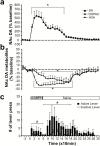Dopamine and glutamate interaction mediates reinstatement of drug-seeking behavior by stimulation of the ventral subiculum
- PMID: 25539503
- PMCID: PMC4368862
- DOI: 10.1093/ijnp/pyu008
Dopamine and glutamate interaction mediates reinstatement of drug-seeking behavior by stimulation of the ventral subiculum
Erratum in
-
Erratum.Int J Neuropsychopharmacol. 2016 Apr 27;19(10):pyw031. doi: 10.1093/ijnp/pyw031. Int J Neuropsychopharmacol. 2016. PMID: 27207904 Free PMC article. No abstract available.
Abstract
Background: Drug addiction is a chronic brain disease characterized by recurrent episodes of relapse to drug-seeking/-taking behaviors. The ventral subiculum, the primary output of the hippocampus, plays a critical role in mediating drug-seeking behavior.
Methods: A d-amphetamine intravenous self-administration rat model was employed along with focal electrical stimulation of the ventral subiculum (20 Hz/200 pulses) to examine its role in reinstatement of drug-seeking behavior. Dopamine efflux in the nucleus accumbens was measured by in vivo microdialysis and subsequent HPLC-ED analyses. Pharmacological antagonism of dopamine and ionotropic glutamate receptors locally within the nucleus accumbens was employed to assess the role of glutamate and dopamine in reinstatement of drug-seeking behavior induced by stimulation of the ventral subiculum.
Results: Here, we demonstrate that reinstatement of drug-seeking behavior following extinction of d-amphetamine self-administration by rats was induced by electrical stimulation in the ventral subiculum but not the cortex. This reinstatement was accompanied by a significant increase in dopamine efflux in the nucleus accumbens and was disrupted by microinfusion of a dopamine D1 or D2 antagonist into the nucleus accumbens. Inhibition of N-methyl-D-aspartate or non- N-methyl-D-aspartate receptors had no effect on the reinstatement induced by ventral subiculum stimulation, whereas co-infusion of D1 and N-methyl-D-aspartate antagonists at formerly ineffective doses prevented drug-seeking behavior.
Conclusions: These data support the hypothesis that dopamine/glutamate interactions within the ventral striatum related to memory processes are involved in relapse to addictive behavior.
Keywords: deep brain-stimulation; dopamine amphetamine-reinstatement; nucleus accumbens; ventral subiculum.
© The Author 2014. Published by Oxford University Press. All rights reserved. For Permissions, please e-mail: journals.permissions@oup.com.
Figures





References
-
- Anderson SM, Bari AA, Pierce RC. (2003). Administration of the D1-like dopamine receptor antagonist SCH-23390 into the medial nucleus accumbens shell attenuates cocaine priming-induced reinstatement of drug-seeking behavior in rats. Psychopharmacology (Berl) 168:132–138. - PubMed
-
- Anderson SM, Schmidt HD, Pierce RC. (2006). Administration of the D2 dopamine receptor antagonist sulpiride into the shell, but not the core, of the nucleus accumbens attenuates cocaine priming-induced reinstatement of drug seeking. Neuropsychopharmacology 31:1452–1461. - PubMed
-
- Bachtell RK, Whisler K, Karanian D, Self DW. (2005). Effects of intra-nucleus accumbens shell administration of dopamine agonists and antagonists on cocaine-taking and cocaine-seeking behaviors in the rat. Psychopharmacology (Berl) 183:41–53. - PubMed
-
- Berger SP, Hall S, Mickalian JD, Reid MS, Crawford CA, Delucchi K, Carr K. (1996). Haloperidol antagonism of cue-elicited cocaine craving. Lancet 347:504–508. - PubMed
-
- Berke JD, Hyman SE. (2000). Addiction, dopamine, and the molecular mechanisms of memory. Neuron 25:515–532. - PubMed
Publication types
MeSH terms
Substances
Grants and funding
LinkOut - more resources
Full Text Sources
Other Literature Sources

